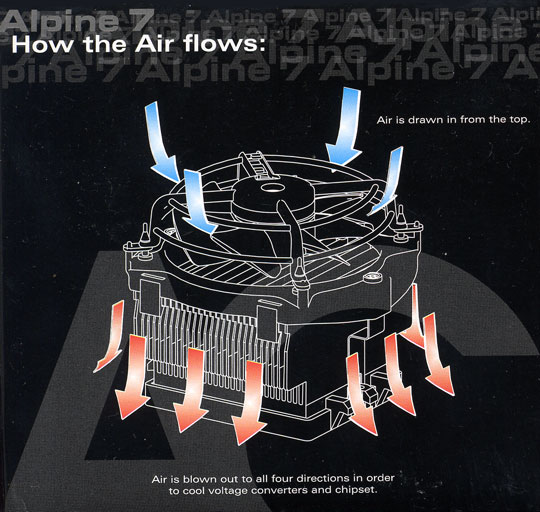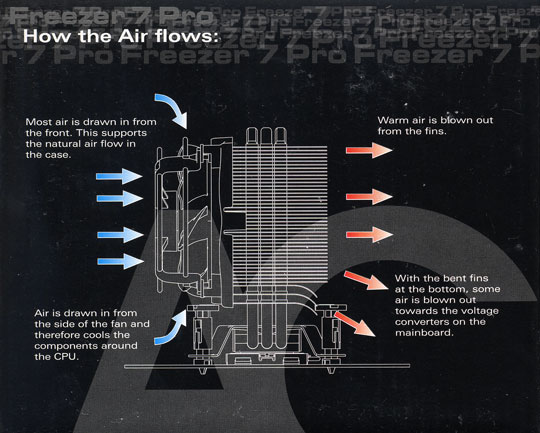Arctic Cooling Duo: Alpine 7 & Freezer 7 Pro Attack Value
by Wesley Fink on January 29, 2008 2:00 AM EST- Posted in
- Cases/Cooling/PSUs
The Arctic Coolers
Both the Alpine 7 and the Freezer 7 Pro use a frameless 92mm fan, but the output and bearing design differ by model. The frameless fan is a design feature that distinguishes Arctic Cooling designs.


The fan mount is also a trademark feature. AC coolers use elastomeric mounts to isolate the fan and reduce noise levels. This is true even on the $12 entry-level Alpine 7 (with PWM) cooler. The frameless fan with elastomeric mounts is a similar design on both coolers, but there little else is the same. The Alpine 7 is a one-piece aluminum block; it uses a traditional down-facing fan, much like the Intel retail cooler and other entry-level coolers.

The Alpine 7 consists of several models. Our test unit is the Alpine 7 (with PWM), which is basically an Alpine 64 with a custom cage for mounting on Socket 775. This model will mount on any current AMD or Intel socket. Other models are the Alpine 64 Pro for Intel 775 only and the Alpine 64/Alpine 64 (with PWM) for AMD only. All these variations use a heatsink that is basically the same and a down-facing fan with the same fan specifications. Performance should be the same across these coolers. Arctic Cooling also has a smaller cooler with a smaller 80mm fan where small size is important, the Alpine 7 GT.

The midrange Freezer 7 Pro is a side-mounted heatpipe tower. Three vertical heatpipes are looped through a heavy base and support horizontal aluminum cooling fins. Airflow exhausts toward the rear fans in the case. All the top performing coolers tested in recent months at AnandTech use a heatpipe tower design.










48 Comments
View All Comments
spidey81 - Tuesday, January 29, 2008 - link
I was looking into the Freezer 64 Pro for an AM2/AM2+ build and was wondering if anyone knew if the performance for the AMD version performed similarly. I noticed the specs seem to be slightly different as the 64 Pro fan maxes out at only 2200 rpm pushing 40 cfm where the 7 Pro maxes out at 2500 rpm pushing 45 cfm. They appear to be of the same design varied only by the mounting hardware. Any input would be greatly appreciated.Martimus - Tuesday, January 29, 2008 - link
I have a Freezer 64 Pro. It dropped the temps on my CPU by 10C instantly from a Zalman 7000. It now runs 20C cooler after the Thermal compound cured. It is definitely a nice heatsink, although it is difficult to attach unless you remove the MB from the case.mixim - Tuesday, January 29, 2008 - link
The design is exactly the same, only the fan circuits differ to reduce the max fan rpm, this because AMD has put out low-watt CPU's for a couple of years now , when the Intel version should still be able to cope with Pentium 5/D's and so on...The lower maximum RPM will help with the fans longevity, but actually in my C2D system it has never went up to full speed anyway...
dlock13 - Tuesday, January 29, 2008 - link
I cannot find the Freezer 7 anywhere under $25. I can't find it anywhere under $30. I checked Newegg and their price is $32.I am really in need of a new heatsink, and this is just perfect.
Spanki - Wednesday, January 30, 2008 - link
It's $24.99 here: http://www.svc.com/acfzp7.html">http://www.svc.com/acfzp7.htmlor.. you can save some bucks and get the Cooler Master Hyper Tx 2 (same or better performance than the Freezer Pro 7 - slightly larger, quieter, slower spinning fan) for $9.99 at the same place: http://www.svc.com/rr-pch-s9u1-gp.html">http://www.svc.com/rr-pch-s9u1-gp.html
BladeVenom - Tuesday, January 29, 2008 - link
Newegg has it on sale for $21.99 quite often. It can also usually be found for $21.86 on sale at eWiz.75below0 - Tuesday, January 29, 2008 - link
I understand there's a new test bed and temp utility, but +7C for the Ultima 90 w/SFLex under load compared to last review seems inordinately steep...Anyone have any comparisons of CoreTemp vs. NVIDIA Monitor and/or Intel TAT (Thermal Analysis Tool) ?
whatthehey - Tuesday, January 29, 2008 - link
The motherboard and BIOS change among other things so the fan speeds may not ramp up as soon but when they ramp up they might do so to a larger amount. Look at the Intel stock cooler which drops from 56C to 50C with the new testbed. They covered a lot of the changes here:http://www.anandtech.com/casecoolingpsus/showdoc.a...">http://www.anandtech.com/casecoolingpsus/showdoc.a...
If you look at the results you'll see that TAT and CoreTemp both register higher than the old EVGA board by several C. Meanwhile the Ultra 120 X goes from 36C to 42C idle and 47C to 59C load. Obviously there are lots of variables. I'm not sure what margin of error is with CoreTemp and such either but it may be several C.
The important thing IMO is to look at noise levels and max OC along with temps. Nothing exists in a vaccuum so don't focus on one metric.
phaxmohdem - Tuesday, January 29, 2008 - link
I just ordered the Freezer 7 yesterday night... before this article came out. I feel WAY better now about my decision... though it is going onto a Pentium-D which may insult it :PRamarC - Tuesday, January 29, 2008 - link
freezer 7 pros are great for pentium Ds. i've got a 3.4ghz pd945 that it keeps in the mid 50s. warm? yes, but quiet since the mobo only asks the freezer to spin at 500rpm.i can't believe it took anandtech this long to review the freezer pro 7 considering mine is pushing 2 years old now.